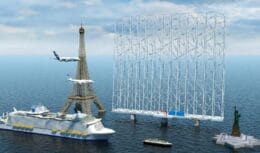
Giants in the oil and gas sector want to install an offshore wind farm in the Campos Basin, on the coast of Rio de Janeiro!
Brazil remains a “market to watch”: is what the 2022 GWEC report says (Global Wind Energy Council) global wind energy forum, and global oil giants such as Shell, TotalEnergies, Petrobras and Equinor target billionaire investments in the Brazilian offshore wind market!
According to data from the National Energy Balance, produced by EPE (Empresa de Pesquisa Energética, a government agency linked to the Ministry of Mines and Energy), the installed power of onshore wind farms jumped from 1,426 GW installed in 2011 (0,5% of the national electricity matrix) to 20,771 GW in 2021 (11,4% of the matrix).
The source was a protagonist in facing the water crisis faced by the country in 2021, representing 12% of the total energy generated in the country – occupying the third position, behind the hydroelectric and thermal source –, avoiding rationing like those verified 20 years ago, in 2001.
Decree that establishes the legal framework for the exploitation of wind energy in the Union's marine domain was published in January
With onshore wind energy – that is, on dry land – evolving “by leaps and bounds”, national and foreign entrepreneurs are starting to launch the first works for the new frontier to be overcome: offshore wind energy.
After much anticipation, Decree nº 10.946/2022 was published in January, which establishes the legal framework for the exploitation of wind energy in the Union's marine domain. In 2020, the “Offshore Wind Roadmap” published by EPE points to the potential for installing 700 GW of power in locations with depths of up to 50 meters, equivalent to almost 4 times all the installed power generation power in Brazil.
The publication of the Decree, despite allowing the first projects to begin to be developed, makes clear the complexity of implementing an undertaking of this type.
From Ibama, responsible for environmental licensing, to the Ministry of Tourism, which will verify the impacts on tourist regions, passing through the Air Force Command (interference in the area approaching airports) and the Ministry of Agriculture, Livestock and Supply (conflicts with aquaculture and fishing), interested parties must maintain dialogue with 9 bodies – in addition to ANEEL itself and MME – to obtain all the necessary licenses for the exploitation of this vast resource.
Even so, Ibama notified, in an April/2022 report, that more than 130 GW of offshore wind power is under the environmental licensing process, reinforcing the interest of entrepreneurs in this market.
The interest includes not only traditional players in the electricity market, such as Neoenergia (from the Spanish group Iberdrola), but also groups with a strong presence in the oil and gas sector, such as Shell, TotalEnergies and Petrobras – which joined forces with Equinor, which already operates offshore wind farms (including plants in the United Kingdom, the northeastern United States and Norway), to evaluate the installation of a wind farm in the Campos Basin, on the coast of Rio de Janeiro.
Synergy between the oil sector, with recognized expertise in building infrastructure in shallow, deep and ultra-deep waters is clear
The synergy between the oil sector, with recognized expertise in building infrastructure in shallow, deep and ultra-deep waters is clear. The sector combines its experience in offshore projects with the desire to invest in renewable sources, driven by pressure from international agreements to develop more sustainable energy policies, interest from the financial market that rewards ESG practices and the population's own desire to consume clean energy.
If on the one hand we have a large availability of offshore wind resources, and on the other we have an already signaled interest in the market to invest in this type of energy, it remains for public policy makers to structure the paths that will lead to this development.
The success of onshore wind power in Brazil is directly linked to contracting in the regulated environment, with PROINFA auctions, Reserve Energy Auctions, Alternative Sources Auctions and a privilege to the source in New Energy Auctions. The breath of this contracting environment for the viability of new ventures, however, reduced significantly.
From 2012 to 2016, 8,4 GW of onshore wind projects were implemented in Brazil
From 2018 to 2021, 4,2 GW of onshore wind projects were made viable, a reduction of almost 50% compared to the 8,4 GW made possible from 2012 to 2016. The reduction in expansion opportunities in the regulated market forced wind energy to target the free market, in a very successful way. Accompanied by greater appetite for risk and maturity of financing agents, the growth of the source did not decelerate with the reduction in demand in the ACR.
Even so, regulated auctions were essential for this source to mature, which allowed for a reduction in installation costs from around R$6.500/kW in 2007 to around R$4.300/kW in 2021, a reduction of more than 30%. The estimated average cost of offshore wind energy by EPE is much higher, in the range of R$ 10.300 /kW. The efficiency gain in energy generation, as a result of greater regularity of winds on water surfaces, will contribute to a reduction in the average cost of energy production, but it is not enough to make the projects financially viable.
Offshore wind source will be a big challenge
With the route of regulated auctions already saturated – and even more threatened by the total opening of the market proposed by PL 414/2021 –, encouraging offshore wind power will be a major challenge to be addressed by public policy makers. How to promote the same curve of falling prices and increasing installation of offshore projects with the same success as the onshore experience without repeating the recipe of relying exclusively on the use of the regulated market for these purposes?
The association with the production of green hydrogen (H2V) may be part of the answer to this question. Hydrogen can be produced through the electrolysis of water, a process that consumes a lot of electrical energy. It is green when that electricity comes from low-carbon sources. The production of hydrogen is an object of interest because it manages to provide more energy per unit mass than other fuels (such as diesel or natural gas), being a very attractive source for energy storage and for use in the transport sector. Because it has only water vapor as a product of its burning, the reduction of emissions in this sector is closely linked to the production of H2V.
The 2020s promise to be marked by progress towards this new frontier, led by offshore wind energy
The formalization and strengthening of a national carbon credit market will also play an important role in making this type of undertaking viable, providing additional revenue to projects beyond the production of electricity itself.
The traditional route of regulated auctions should not be ignored either, with exclusive competitive processes for offshore wind energy starting in 2023.
Finally, the capital market will play a central role in the financing of these undertakings, alongside development and development banks. The issuance of green debentures, in addition to the appreciation of shares in companies with ESG practices, will be a central element in raising funds for the construction of offshore wind farms.
As the 2010s were marked by the expansion of onshore renewable sources, the 2020s promise to be marked by the advance on this new frontier, led by offshore wind energy. The Brazilian continental platforms, which in the last decade attracted investors and provided development with the exploration of oil and natural gas, mainly in the pre-salt layer, now gain renewed relevance, this time with a greener and more sustainable bias.
by - Gustavo Morais, generator management coordinator at Trinity Renewable Energies.













Army summons Brazilians with up to…
Come be a watermelon, you too
Air Force F-16 fighters…
Everything is fine, 100-year secrecy,…
Air Force F-16 fighters…
Well... It's flying scrap... Typical...
Air Force F-16 fighters…
Which genocide are you talking about? Than…
They discover the third largest deposit…
That’s why all foreigners and NGOs…
You didn't read the article, right?
Before commenting, read the article, 100%…
You didn’t read the article, right friend?…
China carried out agrarian reform, which…
Nobody cares what you want, the...
It's written in 100% private matter, no...
Private project, 🤣🤣🤣🤣, my friend at least…
What a pity